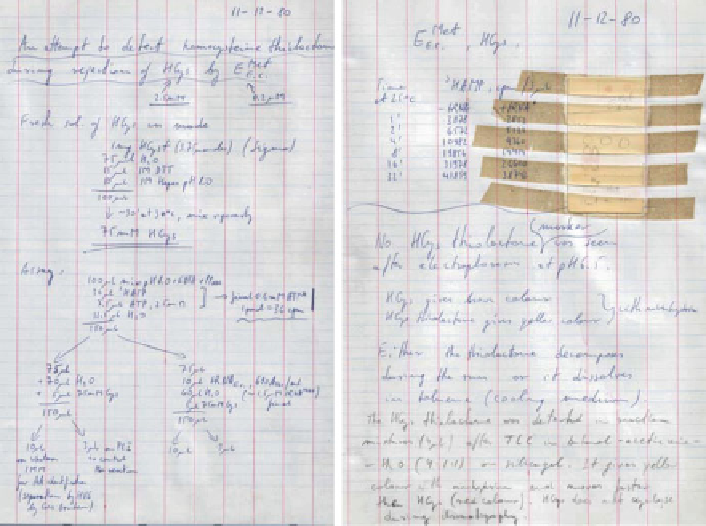Biomedical Engineering Reference
In-Depth Information
Fig. 3.5 Pages from the author's laboratory notebook describing the discovery of Hcy-thiolactone
formation during Hcy editing by MetRS (December 11, 1980). Hcy-thiolactone, formed in the
reaction mixtures containing Hcy, [
14
C]ATP (the radiolabeled form is used as tracer to follow ATP
hydrolysis to AMP during Hcy editing), tRNA, and MetRS, is separated from Hcy by thin-layer
chromatography on a silica plate and detected by staining with ninhydrin (yellow). The original
TLC plate is Scotch-taped in the upper right of the second page. The staining has faded since then,
but the round pencil traces outlining the Hcy-thiolactone spots are visible in the middle of the
plate. The slower migrating elongated spot is Hcy (originally stained red with ninhydrin)
cerevisiae [63]. The evidence that MetRS is responsible for Hcy-thiolactone bio-
synthesis in mammalian cells, including human, came from studies of Hcy-
thiolactone metabolism in cultured human cervical carcinoma (HeLa), mouse
adenocarcinoma (RAG), and Chinese hamster ovary (CHO) cells [138]. Subsequent
studies have demonstrated that the rice Oryza sativa MetRS expressed in E. coli has
the ability to catalyze the conversion of Hcy to Hcy-thiolactone and that MetRS is
involved in Hcy-thiolactone biosynthesis in the plant Lupinus luteus [190].
Extensive cell culture and whole organism studies have established that Hcy-
thiolactone formation during Hcy editing catalyzed by MetRS is universal and
occurs in all organisms and cell types investigated from bacteria [64, 193, 194,
197], yeast [63, 64], and plants [190] to mice [93] and humans [64, 93-95]. Hcy-
thiolactone synthesis during the Hcy editing reaction is also catalyzed by E. coli
leucyl-tRNA and isoleucyl-tRNA synthetases, both in vitro [210] and in vivo [193].
The evidence that Hcy editing is part of MetRS-catalyzed tRNA aminoacylation
with Met in living organisms is summarized below. Also discussed below is the

Search WWH ::

Custom Search